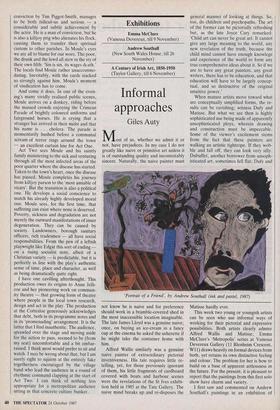Exhibitions
Emma McClure (Vanessa Devereux, till 9 November) Andrew Southall (New South Wales House, till 26 November)
Informal approaches
Giles Auty
Most of us, whether we admit it or not, have prejudices. In my case I do not greatly like naive or primitive art unless it is of outstanding quality and incontestably sincere. Naturally, the naive painter must `Portrait of a Friend', by Andrew Southall (ink and pastel, 1987) not know he is naive and for preference should work in a bramble-covered shed in the most inaccessible location imaginable. The late James Lloyd was a genuine naive; once, on buying an ice-cream in a fancy cup at the cinema he asked the usherette if he might take the container home with him.
Alfred Wallis similarly was a genuine naive painter of extraordinary pictorial inventiveness. His tale requires little re- telling, yet, for those previously ignorant of them, his little fragments of cardboard covered with boats and harbour scenes were the revelations of the St Ives exhibi- tion held in 1985 at the Tate Gallery. The naive mind breaks up and re-disposes the general manner of looking at things. So, too, do children and psychopaths. The art of the former can be pictorially refreshing but, as the late Joyce Cary remarked: `Child art can never be great art. It cannot give any large meaning to the world, any new revelation of the truth, because the child mind cannot have enough knowlege and experience of the world to form any true comprehensive ideas about it. So if we are to have any great painters, any great writers, there has to be education, and that education will have to be largely concep- tual, and so destructive of the original intuitive power.'
When mature artists move toward what are conceptually simplified forms, the re- sults can be ravishing; witness Dufy and Matisse. But what we see then is highly sophisticated use being made of apparently unsophisticated ploys, wherein drawing and construction must be impeccable. Some of the viewer's excitement stems from the fact that these painters are walking an artistic tightrope. If they wob- ble and fall off, they can look very silly. Dubuffet, another borrower from unsoph- isticated art, sometimes fell flat; Dufy and Matisse hardly ever.
This week two young or youngish artists can be seen who use informal ways of working for their pictorial and expressive possibilities. Both artists clearly admire Alfred Wallis and Matisse; Emma McClure's 'Metropolis' series at Vanessa Devereux Gallery (11 Blenheim Crescent, Wit) draws heavily on formal devices from both, yet retains its own distinctive feeling and colour. The problem for her is how to build on a base of apparent artlessness in the future. For the present, it is pleasant to report that the paintings from this first solo show have charm and variety.
I first saw and commented on Andrew Southall's paintings in an exhibition of contemporary Australian art held in March 1985 at Crane Kalman Gallery. The raw, neurotic energy of the oil paintings of that period finds fresh outlet now in the darker and more sensual ink drawings on view at New South Wales House (66 Strand, WC2). The artist again chooses rough informality as a vehicle for feeling and for what might be described as a search for antipodean authenticity. Few concessions are made to prettifying finish as the artist cudgels his paintings into submission rather than coaxing them. When successful, as in `Portrait of a Friend', the result can be moving. Andrew Southall is one of a newly emerging generation of Australian artists with distinctive voices.
In welcoming the newly opened Taylor Gallery (4 The Royal Arcade, Old Bond Street, W1) to the London ranks one must salute their enterprise in trying to run a more or less vertical operation spread over four floors. Following an ambitious exhibi- tion of American Impressionist paintings, which are too rarely seen here, they now bring us Irish art from 1850 to 1950, to which the same sentiment applies. In the early years of this century, Jack Butler Yeats used informal handling and con- struction to bring a vigorous honesty to evocations of his homeland. Other good artists in this show include William Conor, George Russell and Roderic O'Conor. The latter was an uneven artist but capable of brilliance. Not least of his claims to distinc- tion are that Gauguin requested his com- pany on a South Seas sojourn and that Somerset Maugham apparently loathed him. These are excellent credentials.



















































 Previous page
Previous page